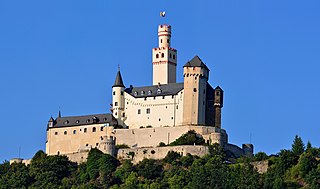History
The Ramburg was built in the 12th century under the House of Hohenstaufen as an imperial castle for the protection of Trifels Castle. It is recorded as the seat of imperial ministeriales from 1163.

An imperial castle or Reichsburg was a castle built by order of the Holy Roman Emperor, whose management was entrusted to Reichsministeriales or Burgmannen. It is not possible to identify a clear distinction between imperial castles and the fortified imperial palaces or Pfalzen, because many imperial castles were used by German kings for temporary stays. A large number of imperial castles were built in regions such as Swabia, Franconia, the Palatinate and the Alsace, where there were a high density of imperial estates (Reichsgüter) during the Hohenstaufen era.

Trifels Castle is a reconstructed medieval castle at an elevation of 500 m (1,600 ft) near the small town of Annweiler, in the Palatinate region of southwestern Germany. It is located high above the Queich valley within the Palatinate Forest on one peak of a red sandstone mountain split into three. Trifels Castle is on the peak of the Sonnenberg, and on both of the other two rock elevations there are castle ruins: Anebos Castle and Scharfenberg Castle.
In 1519, Hans of Ramburg, the last member of the House of Ramburg, sold his castle to the Dalbergs. Six years later the castle was completely razed during the Peasants' War.

The German Peasants' War, Great Peasants' War or Great Peasants' Revolt was a widespread popular revolt in some German-speaking areas in Central Europe from 1524 to 1525. It failed because of the intense opposition by the aristocracy, who slaughtered up to 100,000 of the 300,000 poorly armed peasants and farmers. The survivors were fined and achieved few, if any, of their goals. The war consisted, like the preceding Bundschuh movement and the Hussite Wars, of a series of both economic and religious revolts in which peasants and farmers, often supported by Anabaptist clergy, took the lead. The German Peasants' War was Europe's largest and most widespread popular uprising prior to the French Revolution of 1789. The fighting was at its height in the middle of 1525.
In 1540 the ruins were sold to the counts of Löwenstein. After being totally destroyed by a lightning strike in 1560 it was rebuilt as a residential castle again.
The castle was plundered during the Thirty Years' War, but not destroyed. Until 1638 it remained occupied as district office (Amtsitz), but fell into increasing disrepair and was used as a quarry in the early 18th century.

The Thirty Years' War was a war fought primarily in Central Europe between 1618 and 1648. One of the most destructive conflicts in human history, it resulted in eight million fatalities not only from military engagements but also from violence, famine, and plague. Casualties were overwhelmingly and disproportionately inhabitants of the Holy Roman Empire, most of the rest being battle deaths from various foreign armies. In terms of proportional German casualties and destruction, it was surpassed only by the period January to May 1945; one of its enduring results was 19th-century Pan-Germanism, when it served as an example of the dangers of a divided Germany and became a key justification for the 1871 creation of the German Empire.
This page is based on this
Wikipedia article Text is available under the
CC BY-SA 4.0 license; additional terms may apply.
Images, videos and audio are available under their respective licenses.

Ramberg is a municipality in Südliche Weinstraße district, in Rhineland-Palatinate, western Germany.
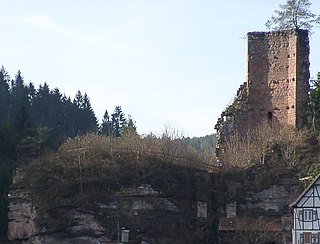
Elmstein Castle is a castle ruin built in the High Middle Ages overlooking Elmstein in the Palatinate Forest in the German state of Rhineland-Palatinate. It was built in the 12th century.

Altdahn Castle is a castle ruin in the Palatinate Forest, the German part of the Wasgau region, and is located near the town of Dahn in Rhineland-Palatinate, Germany. It stands 337 metres (1,106 ft) above sea level (NN).
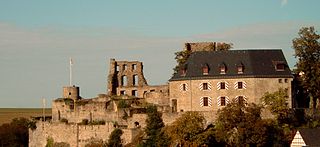
Kastellaun Castle is a ruined medieval castle in Kastellaun in the Rhein-Hunsrück district in Rhineland-Palatinate, Germany.

The Sporkenburg is a late medieval castle ruin about one kilometre south of Eitelborn in the district of Westerwaldkreis in the German state of Rhineland-Palatinate.

Tanstein Castle is the ruin of a rock castle in the southern Palatine Forest, the German part of the Wasgau region. It lies just under 1 kilometre east of the small town of Dahn in the state of Rhineland-Palatinate.

Haardt Castle or Villa Clemm after its builder, is a schloss-like villa in the municipality of Haardt near the town of Neustadt an der Weinstraße in the German state of Rhineland-Palatinate.
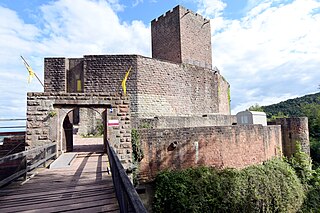
Landeck Castle is a ruined hill castle southwest of Landau, near Klingenmünster in the county of Südliche Weinstraße in the German state of Rhineland-Palatinate.
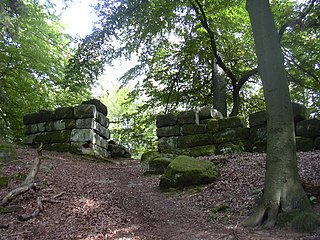
The Heidelsburg, also called the Bunenstein, is an old fortification in the western Palatine Forest in the German state of Rhineland-Palatinate that goes back at least to the days of the Roman Empire. Today only the remains of two gates, together with their steps, the castle walls and a cistern have survived.

Steckelberg Castle is a ruined hill castle near Ramholz, in the borough of the East Hessian town of Schlüchtern in Germany.

Guttenberg Castle is a ruined rock castle near the French border in the German part of the Wasgau, which in turn is part of the Palatine Forest in the state of Rhineland-Palatinate.
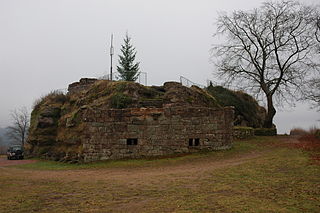
Lemberg Castle is a medieval castle on the territory of Lemberg in the county of Südwestpfalz in the German state of Rhineland-Palatinate.

Lindelbrunn Castle is the medieval ruin of a rock castle near the village of Vorderweidenthal in the county of Südliche Weinstraße in the German state of Rhineland-Palatinate.

The Orensberg, also known in the region as the Orensfels(en) due to the striking rock formations on its summit plateau, is a hill, 581.2 m above sea level (NHN), near Frankweiler in the county of Südliche Weinstraße in the German state of Rhineland-Palatinate. The hill is part of the Haardt mountain range that forms the eastern edge of the Palatinate Forest.
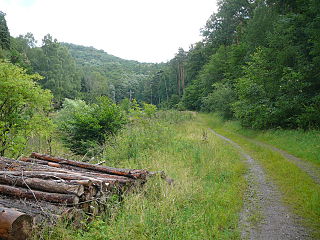
The Holpertal is a valley, just one and a half kilometres long, in the central Palatine Forest of Germany. It lies within the municipality of Ramberg in the county of Südliche Weinstraße in the state of Rhineland-Palatinate. Its V-shaped cross-section was cut by the waters of the Holperbach stream, which has incised deeply into the rock layers of the Lower Bunter. The valley floor climbs from an elevation of about 250 metres to well over 400 metres. Its slopes are covered with mixed forest and sweet chestnut. Whilst at one time, the valley produced raw materials for the traditional broom and brush-making industries, today forestry and tourism predominate.

The Niederburg at Kobern, also called the Niedernburg, Unterburg or Neue Burg, is a hill castle above the municipality of Kobern-Gondorf in the county of Mayen-Koblenz in the German state of Rhineland-Palatinate.
